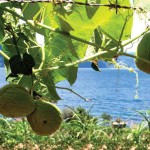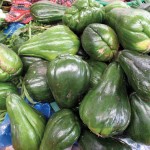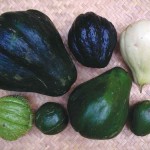Güisquil in Guatemala
- What looks like an avocado, grows on a vine, and tastes like a potato?
- A few of the several varieties of güisquil; used in many of the same ways that the potato is, though it is more tender and has a slightly nutty flavor.
- The tender and delicately spiraled tips of the vine are also harvested to be added to soups and stews. Here they are known as “punta de güisquil.”
- A few of the several varieties of güisquil; used in many of the same ways that the potato is, though it is more tender and has a slightly nutty flavor.
text, photos and recipe by Victoria Stone
Güisquil (pronounced “weeskeel”) is one of the most common vegetables throughout Mexico, Central America and parts of South America. It has been famously described as a vegetable that looks like an avocado and tastes like a potato.
The plant originated in Mexico, where it was known to the Aztecs as chayolt. It is a perennial climbing plant with large leaves resembling grape leaves and a vine that can grow up to 15 meters in length. Its scientific name is Sechium edule, and it belongs to the gourd family Cucurbitaceae along with melons, cucumbers and squash.
As abundantly as güisquil grows, it also has an abundance of names. Depending on the country or region of that country, güisquil is also known as chayote, chayotli, cayota, tayota, cidra, guatila, papa de pobre, papa del aire, vegetable pear, pataste, calabacilla, chilacayote, chiverre, machiche, xuxú, chuchú, cho-cho, christophene and mirlitón.
The most common variety of güisquil is indeed about the size and shape of an avocado, but there the similarity ends. Varieties twice that size and half that size are also found. The skin ranges from light to dark green and is firm, smooth, shiny and a bit furrowed. Another common variety is covered with thorny spines. Two other varieties, though quite different in appearance, are both known by the names güisquil and “perulero.” One of these has a softer, thinner skin, which is so pale as to be almost white. The other, dark green, is much smaller—about the size of a plum, and very tender. And yes, it is used in many of the same ways that the potato is, though it is more tender and juicy and has a mild and slightly nutty flavor. In fact, one of güisquil’s many names is “papa de pobre” (poor man’s potato).
Güisquil is one of the vegetables most used in all of Central America in soups and stews. It’s a pretty sure bet that if you’ve ever eaten a soup or stew in Guatemala, you’ve eaten güisquil. Like the potato, güisquil is a great addition to soups and stews because it serves as a thickening agent. It is even used in industrial food production to thicken fruit juices and baby food. Güisquil can be prepared in any way suitable for summer squash and can also be halved, stuffed and baked like acorn squash.
In certain markets, such as that of Santiago Atitlán or the bigger weekend markets elsewhere, one can be lucky enough to find cooked güisquil. Sold hot and simmered to perfection, this can make a perfect prepared food from the market to bring home. There’s something about having been simmered over a fire in a cauldron with dozens of other güisquils that gives this an especially rich flavor and creamy consistency.
Not only is güisquil easy to grow, abundant and easy to transport, it’s also valued for its protein content and is purported to have anti-inflammatory and cell-regenerative properties. It is also a good source of niacin, vitamin B6, pantothenic acid, magnesium and potassium, amino acids and a very good source of dietary fiber, vitamin C, vitamin K, folate, zinc, copper and manganese.
While the “fruit” of the güisquil is the part most commonly eaten, you can be sure that the ladies in the kitchen who made that stew have also been savoring the seed, which is flat and cream colored and a delicious delicacy when cooked. In Guatemalan households these are special treats saved for children. The fruit can also be eaten raw; though this is uncommon in Guatemala, in some countries it is used in salads. Even the starchy tuberous parts of the root are also edible, but are more often fed to livestock.
The tender and delicately spiraled tips of the vine are also harvested to be added to soups and stews; they are a delicious addition to sautéed vegetable dishes. Here they are known as “punta de güisquil” and can be found in local markets only in the seasons when güisquil is in its early growth spurts.
One of my favorite güisquil dishes is the Mayan omelette because of its similarity to a Spanish omelette, using güisquil in place of potatoes.
Mayan Omelette
(one serving—multiply per serving)
1 medium-size güisquil
1-2 eggs
1-2 tablespoons flour
1-2 tablespoons chopped onionsPinch of salt & pepper to taste
Optional: 1-2 teaspoons. parsley or other chopped greens, 1-2 teaspoons, grated cheese
Parboil the güisquil until it can be easily pierced with a fork, 10-15 min. cooking time.Let cool, peel and cut into cubes, discarding the fiber and membrane around the seed. Scramble the eggs, add cubed güisquil, sprinkling in flour to thicken, and salt, pepper, parsley or other greens and/or cheese to taste. Now you’re ready to cook the omelette, covered, in an oiled pan on a medium flame, turning both sides until done.
¡Buen provecho!




Pingback: Post #1: Amarillo Soup Recipe « Kiyokotown